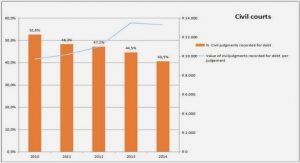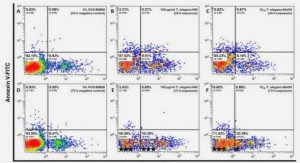Get Complete Project Material File(s) Now! »
ABSTRACT
Tomato production was an important economic activity in the Limpopo Province of South Africa. A clear tomato yield gap existed between South Africa and the other countries in Southern Africa. Understanding the reasons behind tomato crop failures and successes in South Africa could increase tomato production in the fast-growing tomato markets of Angola, Mozambique and Zimbabwe, thereby improving food and nutrition security for smallholders and the population in general. In this study, the i) economics of tomato production in South Africa was investigated and compared to similar production systems in the USA, Turkey and India, ii) the interactions between biotic and abiotic factors that limited tomato yield and quality within three climatically distinct planting windows in the Limpopo Province of South Africa were examined, and iii) the correlations between three commercially available soil health metrics (i.e., a microscope-based method for estimating the biomass of soil bacteria, fungi and protozoans; nematode community profiling based on counts and trophic group classifications and related indices; polyphasic soil health testing based on soil biological, physical and chemical variables) and tomato yield were assessed. Meta-analysis was used to explore yield variation in open field production systems in the international context.
The main yield-limiting factors were identified as planting times, planting density, soil-water relations, and synthetic/organic nitrogen fertilization. The focus of the study shifted to commercial tomato production in the Limpopo Province of South Africa. Since 2003, these tomato producers practiced intensive open field tomato production using a combination of synthetic and organic soil, crop and pest management technologies. A review of tomato production economics revealed that within a period of six years, South African tomato production cost per hectare more than doubled but the profit margin halved.
The importance of tomato quality as an economic factor was demonstrated. Economic pressures forced these tomato producers to intensify production, which underscored the need for the continued development of sustainable tomato production systems. To achieve this strategic goal, the primary biotic and abiotic factors that limited tomato production were identified. The results indicated that complex interactions between biotic and abiotic factors explained yield and quality variation. Climate variation dominated crop productivity, especially in unsuitable planting windows. Soil and crop management variables, notably synthetic fertilizer and pesticide usage, ensured high quality yield. Soil biology management was an important aspect of sustainable agriculture and the use of appropriate soil biology metrics facilitated soil biology management at field scale.
All three soil biology metrics were sensitive to distinguish between three types of disturbed soils commonly encountered in the open field tomato production context: natural, disturbed and cultivated soils. The microscope-based method used for quantifying bacterial, fungal and protozoan biomass and numbers was unsuitable for explaining yield variation. Nematode community profiling, in conjunction with polyphasic soil health testing, was very useful for explaining yield variation. In particular, soil pH, boron, aggregate stability, Paratrichodorus spp. and the balance among soil cations (especially exchangeable K and Mg) explained yield variation. In conclusion, sustainable open field tomato production depends on the integrated use of synthetic and organic crop nutrition and protection technologies, optimum planting times, disease-resistant genetic material, and cultivation on healthy soils. The findings of this study will benefit policy development in support of sustainable vegetable production in the rural areas of Southern Africa.
INTRODUCTION
In order to adequately feed the growing global population, research efforts focus on identifying and closing the yield gap for several important crops. Yield gap is defined as the difference between potential yield and the actual yield that realized in the fields (Van Ittersum et al. 2013, Van Wart et al. 2013ab). Yield gap management is an important step towards regional, national and global food security (Shen et al. 2013a, Smith 2013, Van Ittersum et al. 2013, Pasuquin et al. 2014, Sinclair et al. 2014). The tomato is an important vegetable with a range of reported nutritional and health benefits (Dorais et al. 2008). A tomato yield gap exists in many parts of the world (Asare-Bediako et al. 2007, Barman 2007).
A cursory review of the FAOSTAT database confirmed the tomato yield gap that existed between South African and other Southern Africa Development Corporation (SADC) tomato growers: South African tomato growers achieved an average yield of 72.4 t ha-1 in 2013 against 2.7-13.0 t ha-1 for the other SADC countries (FAOSTAT 2015). Understanding the reasons behind tomato crop failures and successes in South Africa could boost tomato production in the fast-growing tomato markets of Angola, Mozambique and Zimbabwe, thereby improving food and nutrition security for smallholders and the population in general. The focus of this study was to identify biotic and abiotic factors and the role played by each in sustainable tomato production in South Africa Tomato yield and quality is a function of several possible variables: climate, soil, cultivar, management, pest and disease control, plant nutrition, and irrigation.
The interactions between these variables are likely to be complex, making it difficult to inform tomato producers on best management practices for sustainable tomato production in Southern Africa. The tomato is a popular experimental crop and literature contains many references to these likely yield- influencing variables. However, there is a need for identifying and ranking the megatrends that influence tomato production in the multidisciplinary context. Meta-analyses are effective tools for exploring complex questions that are difficult to answer by means of traditional experimentation (Doré et al. 2011, Maillard and Angers 2013, Slattery et al. 2013, Van Kessel et al. 2013, Ugarte et al. 2014).
CONTENTS :
- Declaration
- Acknowledgements
- List of tables
- List of figures
- List of abbreviations
- Abstract
- INTRODUCTION
- CHAPTER 1: LITERATURE REVIEW
- 1.1 Introduction
- 1.2 Tomato yield gap analysis
- 1.3 Meta-analysis
- 1.3.1 Categorical variables
- 1.3.2 Inferred variables
- 1.3.3 Dataset and analyses
- 1.4 Results and Discussion
- 1.4.1 Yield and planting density
- 1.4.2 Soil-water relations
- 1.4.3 Nitrogen nutrition management
- 1.4.4 Production system
- 1.5 Soil biology: the final frontier?
- 1.6 Conclusions
- CHAPTER 2: ECONOMICS VS. ECOLOGY: A CASE STUDY FROM THE SOUTH AFRICAN TOMATO INDUSTRY
- 2.1 Introduction
- 2.2 Materials and methods
- 2.3 Results and discussion
- 2.3.1 Tomato cultivation in South Africa
- 2.3.2 A review of open field tomato production costs
- 2.3.3 South African tomato prices
- 2.4 Economy vs ecology
- 2.5 Lessons for the global tomato-producing community
- CHAPTER 3: THE INFLUENCE OF CLIMATE VARIABILITY ON TOMATO YIELD IN THE LIMPOPO PROVINCE (SOUTH AFRICA)
- 3.1 Introduction
- 3.2 Materials and methods
- 3.2.1 Tomato production region
- 3.2.1 Tomato production system
- 3.2.3 Data sets
- 3.2.4 Data analysis
- 3.3 Results
- 3.3.1 Inter- and intra-year variation in yield and quality
- 3.3.2 Early planting time
- 3.3.3 Optimum planting time
- 3.3.4 Late planting time
- 3.4 Discussion
- 3.4.1 Methodology: advantages and disadvantages
- 3.4.2 Regional focus
- 3.4.3 The usefulness of climate summaries
- 3.4.4 The climate differences between planting times
- 3.4.5 Adaptation strategies in the face of climate variation
- 3.5 Conclusions
- CHAPTER 4: INTERACTIONS BETWEEN CLIMATE, SOIL, AND CROP MANAGEMENT VARIABLES INFLUENCE TOMATO YIELD AND QUALITY IN THE LOWVELD BIOREGION OF SOUTH AFRICA
- 4.1 Introduction
- 4.2 Materials and methods
- 4.2.1 Tomato production region
- 4.2.2 Tomato production system
- 4.2.3 Data sets
- 4.2.4 Data analysis
- 4.3 Results
- 4.3.1 Early planting time
- 4.3.2 Optimum planting time
- 4.3.3 Late planting time
- 4.4 Discussion
- 4.4.1 The relevance of synthetic pesticides
- 4.4.2 The feasibility of organic pest control
- 4.4.3 The importance of synthetic fertilizers
- 4.4.4 The dominant effect of climate on crop productivity
- 4.4.5 The role of benign soil microbiology in crop production
- 4.4.6 Inconsistent CART analysis results
- 4.5 Conclusions
- CHAPTER 5: EXPLORING THE RELATIONSHIP BETWEEN MICROSCOPY-BASED SOIL BIOLOGY MEASUREMENTS AND TOMATO YIELD IN SOUTH AFRICA
- 5.1 Introduction
- 5.2 Materials and methods
- 5.2.1 Tomato production region
- 5.2.2 Tomato production system
- 5.2.3 Sampling strategy
- 5.2.4 Soil biology analyses
- 5.2.5 Soil physical and chemical analyses
- 5.2.6 Statistical procedures
- 5.3 Results
- 5.3.1 Soil management
- 5.3.2 Soil biology and tomato yield
- 5.4 Discussion
- 5.4.1 Significance of the study
- 5.4.2 Soil management
- 5.4.4 Soil biology and tomato yield
- 5.4.5 Limitations of the study
- 5.5 Conclusions
- CHAPTER 6: NEMATODE COMMUNITY PROFILING AS A SOIL BIOLOGY MONITORING TOOL IN SUPPORT OF SUSTAINABLE TOMATO PRODUCTION
- 6.1 Introduction
- 6.2 Materials and methods
- 6.2.1 Tomato production region
- 6.2.2 Tomato production system
- 6.2.3 Sampling strategy
- 6.2.4 Analyses
- 6.2.5 Data analysis
- 6.3 Results
- 6.3.1 Soil management
- 6.3.2 Correlations with tomato yield
- 6.4. Discussion
- 6.4.1 NCP and the soil disturbance gradient
- 6.4.2 NCP and tomato yield
- 6.4.3 NCP in perspective
- 6.4.4 Helicotylenchus spp. as soil health indicator
- 6.4.5 Paratrichodorus spp.: a ‘new’ threat to tomato producers?
- 6.5 Conclusions
- CHAPTER 7: APPLICATION OF INTEGRATED SOIL HEALTH TESTING IN SUPPORT OF SUSTAINABLE TOMATO PRODUCTION IN SOUTH AFRICA
- 7.1 Introduction
- 7.2 Materials and methods
- 7.2.1 Site description
- 7.2.2 Sampling strategy
- 7.2.3 Analyses
- 7.2.4 Data analysis
- 7.3 Results
- 7.3.1 Soil management
- 7.3.2 Tomato yield
- 7.4 Discussion
- 7.4.1 Soil health indicators
- 7.4.2 Soil health vs. crop productivity
- 7.5 Conclusion
- SUMMARY AND CONCLUSIONS
- REFERENCES






